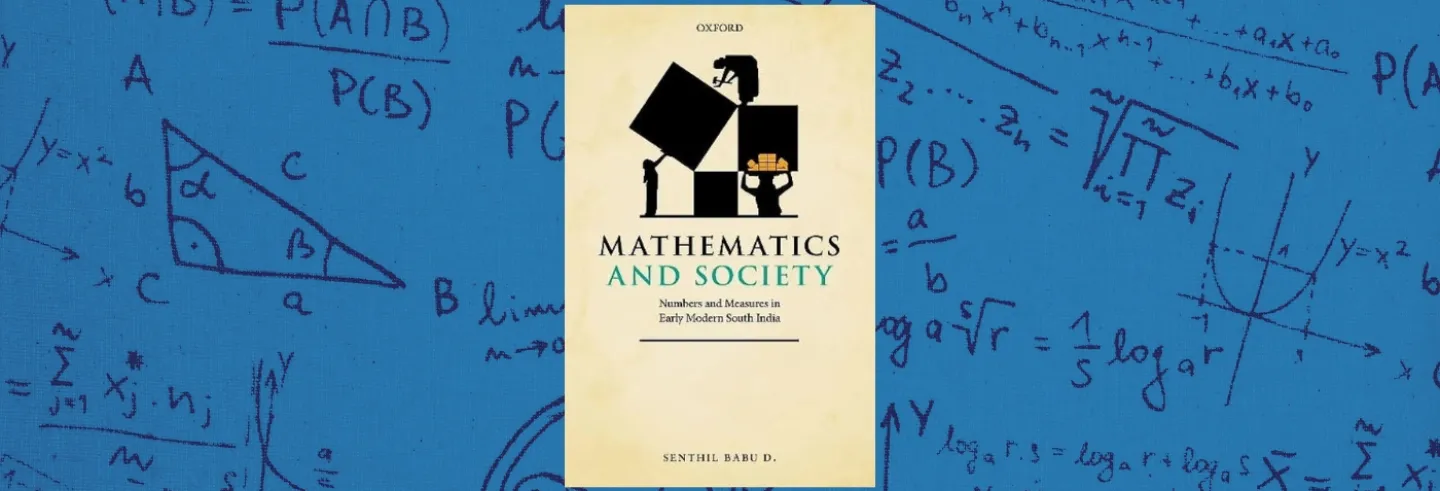Measurement and conversion constituted the vital axis around which the system of land revenue and exercise of power revolved, whether in the Mughal empire or the southern kingdoms. As Senthil Babu shows in his new book, mathematics was integral to land control, revenue extraction and distribution of social product, as well as to different crafts, irrigation, and cultivation.
Surveying early modern mathematical texts in Tamil and other ‘vernacular’ languages, used both by professionals and for teaching in indigenous elementary schools, Babu seeks to explain their peculiar combination of abstraction and practical application. He locates this in the social context of those engaged with mathematical knowledge and the class and caste background of those who generated, taught, and used this knowledge.
Solving a problem
A typical Kanakkatikaram, an early modern Tamil mathematics text, was organised into application areas like the measurement of land, grain, gold, or stone, as encountered by moneychangers, stone cutters, employers, and revenue officials. In particular, these texts were addressed to the village accountant (the ur kanakkan), who, like the European miller, was universally suspected and despised, but central to settling issues relating to land ownership, inheritance, partition, sale, purchase, revenue, apportionment of the produce among the ‘village servants’, and wage payments – in sum, the political economy of a caste-based agrarian society.
The Kanakkatikaram helped an accountant or a trainee to pick the right problem type to apply in real-life contexts.
All these functions involved critical use of measurement, calculation, and conversion. The Kanakkatikaram helped an accountant or a trainee to pick the right problem type to apply in real-life contexts rather than supplying abstracted ‘rules’ for their solution.
The reluctance to enter the world of generalisation of rules (such as the ‘rule of three’) may appear enigmatic. But in a caste society, the movement from knowing how to solve a problem to why the numbers behaved so (and back) was not as natural as it may logically seem. Babu suggests that the reason may lie in the distinct social roles and positions of the astrologer-mathematicians and the accountants who used the vernacular texts.
Babu relates the focus of these texts on proportions, equivalences, conversions, and measurements to the world of practitioners – accountants, goldsmiths, builders, or sculptors – who engaged precisely with these aspects of mathematical knowledge. He points out the vital role relative proportions played in practical craft production. For instance, in the taalamaana system, the length of the face of an image becomes the basic unit for determining the relative size of the rest of the body. The art historian Stella Kramrisch, in her The Hindu Temple, has shown how in temple architecture, the garbhagriha forms a similar basic unit for the entire temple as the relative sizes of various components of the temple are expressed in terms of this basic unit.
A mathematical system conditioned by ‘measuremental’ and proportional thinking might have had a functional utility in rural societies based on land control and caste. But it was also a form of mathematical thought, abstraction, and pleasure, distinct from a system of abstracted and linear numbers. In a caste society which segregated and castled communities and established hierarchies between functions, the physical acts of measurement, calculating, and engaging in the pleasure of playing with numbers were also marked by social hierarchy and access restrictions.
Every social segment, from the Dalit watchman and canal water distributor to the Brahmin landlord, was involved in generating this knowledge.
But we should not absolutise such characteristics, as knowledge enshrined as simple verses and riddles percolated and leaked across the social divisions just as abstract philosophical speculation did. Every social segment, from the Dalit watchman and canal water distributor to the Brahmin landlord, was involved in generating this knowledge; however excluded some groups may have been from the processes of formalisation and transfer of knowledge. This collectively produced knowledge was appropriated and packaged as products of exclusive upper caste reflective thinking, which then percolated or leaked downwards.
Remembering facts
The mathematics taught in the indigenous tinnai schools was an aid to measurement and calculations around these measurements, rather than an aid to mathematical abstraction and number theory or introduction to the ‘four operations’ or even to counting in linear order.
The three elementary mathematical texts, the Ponnilakkam, the Nellilakkam and the Encuvati, which Babu analyses, typically begin with fractions and addition facts of fractions, and build up towards whole numbers. What may appear a pedagogical absurdity of commencing a math primer with 1/320 + 1/320 (muntiri + muntiri or cevitu + cevitu) makes sense because they were also the smallest units of measurement, encountered constantly in daily life. The units of numbers (rather the fractions) are also units of measurement of land, liquids, or grains, and the relations between the fractions are also the relations between different units of measurement and conversion of one unit into another. (Also, premodern literature had no exclusive category of ‘children’s’ literature or ‘school textbooks’; children and adults share the same kind of texts.)
The texts and the pedagogy emphasised memorising addition or conversion facts rather than physical counting or measurement. This was not only because of the emphasis on ‘mental math’ problem solving, without recourse to pencil and paper. It was also a caste-based specialisation of function between the educated accountant who calculated on the one hand and on the other, the Dalit vettiyan who measured land or the Dalit patiyaal who measured grain, but were denied formal education or access even to the tinnai school.
The texts and the pedagogy emphasised memorising addition or conversion facts rather than physical counting or measurement.
In contrast to the Mughal world, the Tamils did not use the place value system which was more conducive to the use of pen and paper to calculate fractions and large sets of numbers. Instead, it used distinct symbols for ten, hundred, and thousand. This necessitated the recourse to doing all the calculations in the mind and then recording the results on paper or palm leaf. Here, quick recall of computation facts became vital for a practising accountant. This may be one of the reasons for what the observers saw as an inordinate emphasis on memorisation in the indigenous schools.
The new mathematics
Early colonial observers of the tinnai schools decried the emphasis on memorisation instead of application. The colonial model of sustaining the indigenous schools sought to induce them gradually to adopt new pedagogy and curriculum through a system of result-based incentive payments.
Babu contends that the colonial critique and attempted reforms of the mass education system were related to the colonial revenue regime with its brand of standardisation of weights and measures. Unlike in older documents, landed property was no longer just measured and defined in terms of its location vis a vis neighbouring fields or landmarks, but also through triangulated mapping. This was accompanied by the use of English weights, measures, and standards.
The maths curriculum and pedagogy that emerged was thus a combination of the colonial and upper caste/class male interests.
This process, begun in the late 18th century, was completed by the middle of the 19th century. It necessitated a dialogue between the older accountants and land measurers on the one hand and the new ‘surveyors’ and settlement officials on the other. A new kind of mathematical knowledge and practice was expected of the students graduating from the tinnais.
If colonialism placed such new demands, the indigenous elite also sought to protect its caste- and land-based privileges by controlling access to the new knowledge, which in turn gave access to power. The maths curriculum and pedagogy that emerged was thus a combination of the colonial and upper caste/class male interests. A new system of absolute numbers replaced the old number system. The new mathematics required a shift to the place-value system and the ability to calculate on paper using columnar operations. A market emerged in printed textbooks for both new colonial and indigenous schools, eventually preparing students for employment in the lower bureaucracy.
The shift to a number system based on place-value marks a major pedagogic shift, which remains the Waterloo for children in elementary grades to this day. It was not a mere substitution of one set of symbols with another; it required a conceptual leap. The idea was not easy to grasp and conceptualise, even for early textbook writers like P. Ramasamy Naicker, whose 1825 Kanitadeepikai inaugurated this ‘new mathematics’. Babu points out that “While introducing place value […] Ramasamy […] simply said, ‘take it as the rule of God.’” The new curriculum sought to free the brain from memorising vast mathematical facts and instead focus on the ability to apply itself to selecting the operations and doing them on paper using place value algorithms. It was in these skills that the tinnai graduates were found wanting.
The new mathematics took hold through the university system and the system of coaching candidates for public examinations.
Yet, the tinnai schools continued to consolidate themselves as ubiquitous primary education institutions, a fact grudgingly accepted by the administration. It was much later in the second half of the 19th century that the new mathematics took hold through the university system and the system of coaching candidates for public examinations, which too relied a lot on memorisation, but of a different kind. Interestingly, both the ‘mathematic public’ and the employers found graduates from purely modern schooling inadequate and argued for a return to the tinnai curriculum and pedagogy. The developments led to a compromise in 1881, which combined elements of both.
Mathematics and Society shows that mathematical knowledge and pedagogy are deeply embedded in the caste-class-gender hierarchy and power structures and thus links them to issues of social justice. This fascinating account of the transition of math curriculum and pedagogy from pre-colonial to colonial times is also a valuable addition to the literature on the history of education in India. Babu helps us go beyond the romanticisation of ‘indigenous’ schooling advocated by the Gandhian thinker Dharampal and unpack its complexities. It has deep implications for intellectual historians as well as maths educators and social activists engaged in struggles for equity and justice.
CN Subramaniam worked in Eklavya developing social science curricula, text books, and teacher education materials. He now studies caste and the intellectual history of premodern Tamil Nadu.









